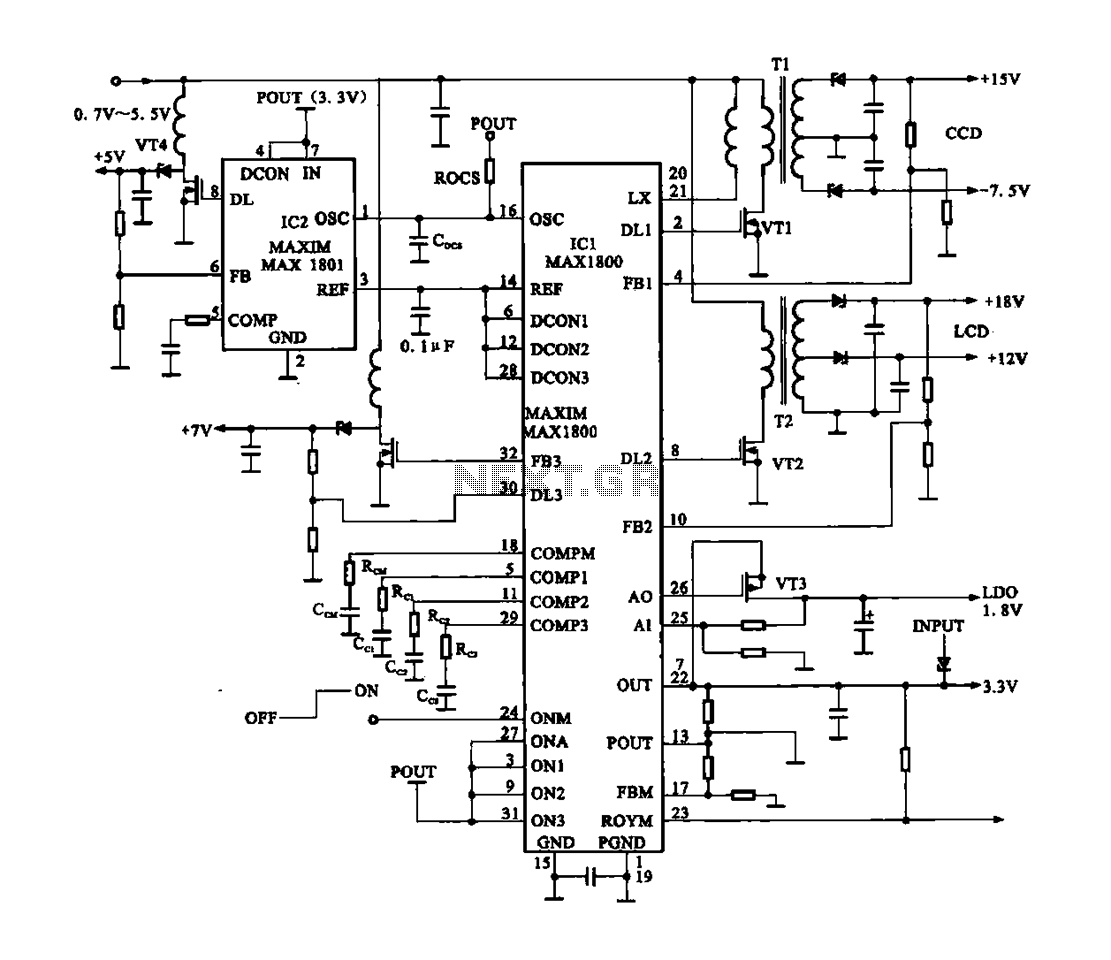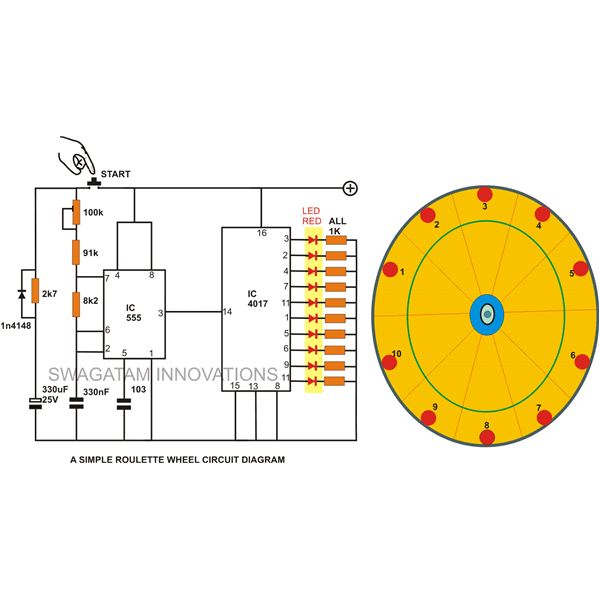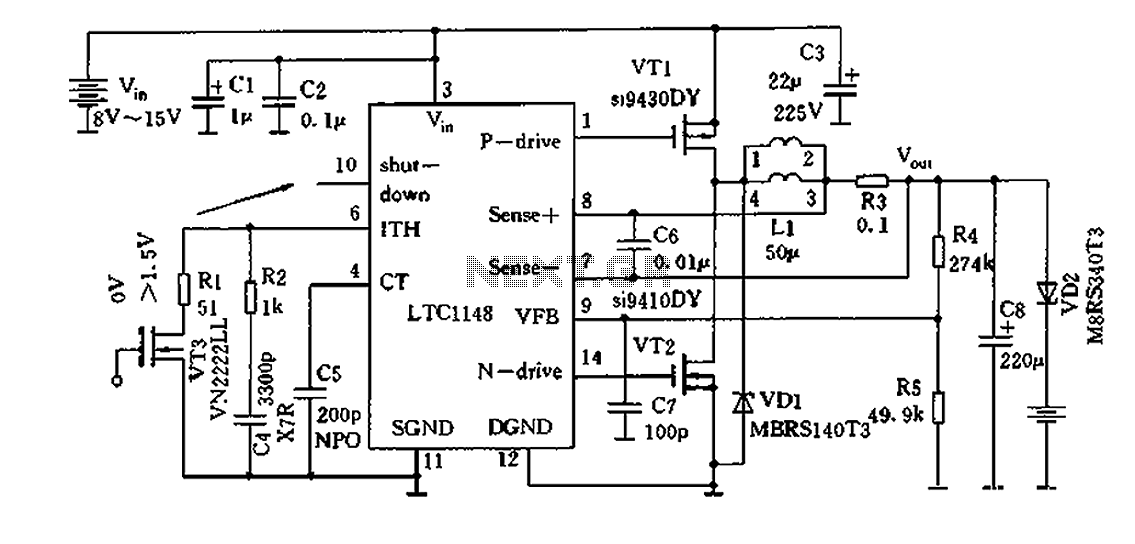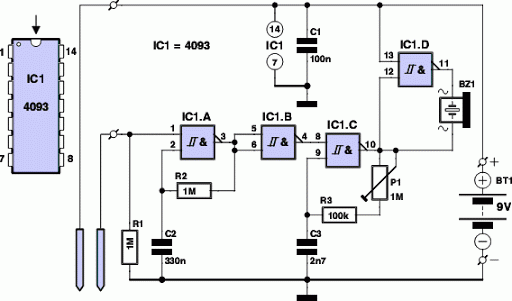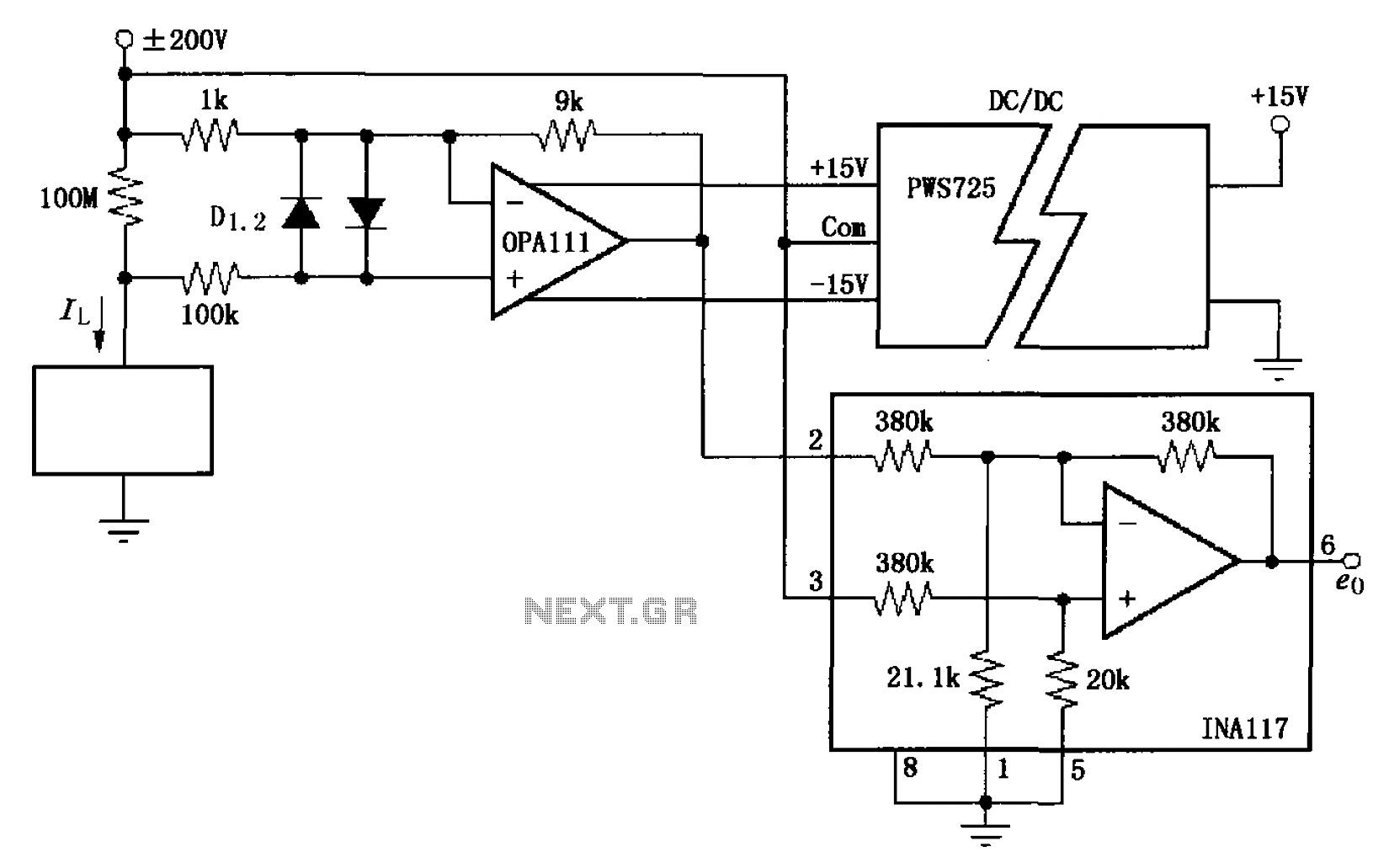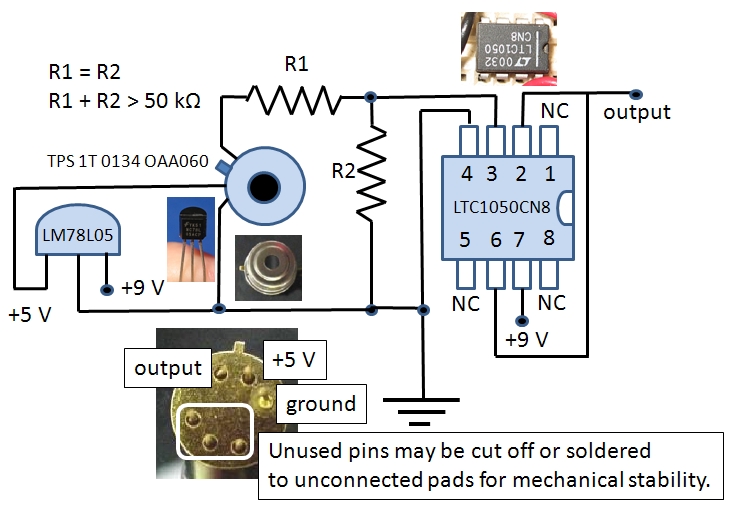
Multivibrator circuit

The 555 timer integrated circuit (IC) is an exceptionally versatile component utilized in various applications, including generating clock pulses, switch debouncing, and functioning as an output transducer. The standard 555 IC is packaged in an 8-pin configuration, available in Dual In-line Package (DIL) and Small Outline Integrated Circuit (SOIC) formats. It operates within a voltage range of 3-15V and is recognized for its robust nature. The frequency and mark-space ratio are determined solely by the values of resistors R1, R2, and capacitor C1. For achieving a roughly equal (1:1) mark-space ratio, R1 is typically set to 1K, while R2 and C1 are adjusted to modify the frequency. For enhanced control over the mark-space ratio, an alternative circuit configuration can be employed. This variation incorporates a diode between Pins 6 and 7, with the cathode connected to Pin 6. This configuration allows the shunting of resistor R2 during the charging of C1, enabling C1 to charge only through R1. Consequently, R2 is excluded from the "high-time" calculation, simplifying the determination of the mark-space ratio and minimizing excessive frequency alterations due to changes in the mark-space ratio, although some variation may still occur. This astable configuration uses fewer components than the basic astable design, requiring only the IC, one resistor, one capacitor, and an additional capacitor connected to Pin 5 for final versions. The resulting astable circuit achieves a mark-space ratio of approximately 1:1; however, this ratio may increase under heavy current loads, as the output does not reach the full power supply voltage. It is important to note that this astable configuration is not a reliable frequency source and should not be employed in applications requiring an accurate and stable clock. Pin 4 is typically held high, rendering it inactive; however, when Pin 4 is driven low, the 555 timer is disabled, and the output is maintained low. This feature can be utilized to activate the astable circuit as needed. An example of this application is the double-astable bleeper, which utilizes the output from one astable to trigger another, faster astable circuit. The component values and frequency are measured in standard base units: ohms, farads, and hertz. These units can be inconvenient, as component values often differ significantly from the base units. Alternative, more convenient units can be used for frequency calculations, with common combinations provided below. This configuration consists of a single 555 astable circuit, which is highly versatile and can serve numerous functions, primarily used to generate a clock signal for circuit operation. The circuit described produces a pulse frequency of approximately 2Hz with a very low mark-space ratio. The corresponding circuit diagram is provided below.
The 555 timer IC can be configured in various modes, including monostable and astable modes, allowing for a wide range of applications. In astable mode, the circuit continuously oscillates between high and low states, generating a square wave output. This output can be used to drive LEDs, generate audio tones, or serve as a timing signal for other digital circuits. The frequency of oscillation is determined by the values of the resistors and capacitor used in the circuit, which can be calculated using the formula:
\[ f = \frac{1.44}{(R1 + 2R2)C1} \]
Where \( f \) is the frequency in hertz, \( R1 \) and \( R2 \) are in ohms, and \( C1 \) is in farads. The mark-space ratio can be adjusted based on the resistor values, allowing for customization of the output waveform characteristics. The addition of a diode in the alternative configuration simplifies the calculation of the mark-space ratio by isolating R2 from the charging cycle of C1, thus providing a more stable output.
In practical applications, the 555 timer is often incorporated into larger systems, such as timers, pulse-width modulation controllers, and frequency generators. Its ability to function across a wide voltage range and its relatively low cost make it a popular choice among engineers and hobbyists alike. The 555 timer IC's robust design ensures reliability in various environments, making it suitable for both prototyping and production applications.The 555 timer IC is a very versatile and useful component and can be used for many things, from giving clock pulses to switch debouncing and as an output transducer. The basic 555 IC is housed in an 8-pin carrier, and these come in DIL and SOIC formats. They run from 3-15V, and are generally quite hardy devices. The frequency and mark-space ratio are defined by the values of R1, R2 and C1 only. For a roughly even (1:1) mark-spce ratio, R1 is usually set at 1K, and the other resistor (R2) and capacitor are changed to alter the frequency. If better control over the mark-space ratio is required, use the next circuit. This variation allow much easier control of the mark-space ratio without too much impact on the frequency.
The only difference is a diode petween Pins 6 and 7, with the cathode at Pin 6. The effect of this is to shunt resistor R2 when charging C1. This means that C1 charges though R1 only. This removes R2 from the "high-time" equation, and make calculating the mark-space ratio easier and prevents the frequency from being altered excessively by changes in the mark-space ratio ( although this still happens to a certain extent). This astable uses fewer components than the basic astable, and requires only the IC, one resistor and one capacitor, plus the Pin 5 capacitor for final versions.
This astable has a MSR of approximately 1:1, but this tends to increase under heavy current load, as the output does not swing fully to the power supply. This astable is not a reliable source of frequency, and should never be used where an accurate, stable clock is needed.
Pin 4 is normally held high, and in this state it does nothing. However, when Pin 4 is brought low, the 555 is disabled, and the output is held low. This can be used to turn an astable on when desired. An example of this is the double-astable bleeper, which uses the output from one astable to enable another, faster astable. The units that the components values and frequency are measure in are the standard base units: ohms, farads and hertz.
This are often inconvenient, as the value for componets are usually several orders of magnitude away from the base unit. It is possible to use more conveninet units to calculate the frequency, and the common combinations are given below: This plugin consists of a single 555 Astable.
This plugin is very versatile, and can be used for any number of things, but it often is used to give a clock to run a circuit. The plugin below gives a pulse of about 2Hz with a very low mark-space ratio. The circuit diagram is given below. 🔗 External reference
The 555 timer IC can be configured in various modes, including monostable and astable modes, allowing for a wide range of applications. In astable mode, the circuit continuously oscillates between high and low states, generating a square wave output. This output can be used to drive LEDs, generate audio tones, or serve as a timing signal for other digital circuits. The frequency of oscillation is determined by the values of the resistors and capacitor used in the circuit, which can be calculated using the formula:
\[ f = \frac{1.44}{(R1 + 2R2)C1} \]
Where \( f \) is the frequency in hertz, \( R1 \) and \( R2 \) are in ohms, and \( C1 \) is in farads. The mark-space ratio can be adjusted based on the resistor values, allowing for customization of the output waveform characteristics. The addition of a diode in the alternative configuration simplifies the calculation of the mark-space ratio by isolating R2 from the charging cycle of C1, thus providing a more stable output.
In practical applications, the 555 timer is often incorporated into larger systems, such as timers, pulse-width modulation controllers, and frequency generators. Its ability to function across a wide voltage range and its relatively low cost make it a popular choice among engineers and hobbyists alike. The 555 timer IC's robust design ensures reliability in various environments, making it suitable for both prototyping and production applications.The 555 timer IC is a very versatile and useful component and can be used for many things, from giving clock pulses to switch debouncing and as an output transducer. The basic 555 IC is housed in an 8-pin carrier, and these come in DIL and SOIC formats. They run from 3-15V, and are generally quite hardy devices. The frequency and mark-space ratio are defined by the values of R1, R2 and C1 only. For a roughly even (1:1) mark-spce ratio, R1 is usually set at 1K, and the other resistor (R2) and capacitor are changed to alter the frequency. If better control over the mark-space ratio is required, use the next circuit. This variation allow much easier control of the mark-space ratio without too much impact on the frequency.
The only difference is a diode petween Pins 6 and 7, with the cathode at Pin 6. The effect of this is to shunt resistor R2 when charging C1. This means that C1 charges though R1 only. This removes R2 from the "high-time" equation, and make calculating the mark-space ratio easier and prevents the frequency from being altered excessively by changes in the mark-space ratio ( although this still happens to a certain extent). This astable uses fewer components than the basic astable, and requires only the IC, one resistor and one capacitor, plus the Pin 5 capacitor for final versions.
This astable has a MSR of approximately 1:1, but this tends to increase under heavy current load, as the output does not swing fully to the power supply. This astable is not a reliable source of frequency, and should never be used where an accurate, stable clock is needed.
Pin 4 is normally held high, and in this state it does nothing. However, when Pin 4 is brought low, the 555 is disabled, and the output is held low. This can be used to turn an astable on when desired. An example of this is the double-astable bleeper, which uses the output from one astable to enable another, faster astable. The units that the components values and frequency are measure in are the standard base units: ohms, farads and hertz.
This are often inconvenient, as the value for componets are usually several orders of magnitude away from the base unit. It is possible to use more conveninet units to calculate the frequency, and the common combinations are given below: This plugin consists of a single 555 Astable.
This plugin is very versatile, and can be used for any number of things, but it often is used to give a clock to run a circuit. The plugin below gives a pulse of about 2Hz with a very low mark-space ratio. The circuit diagram is given below. 🔗 External reference
Warning: include(partials/cookie-banner.php): Failed to open stream: Permission denied in /var/www/html/nextgr/view-circuit.php on line 713
Warning: include(): Failed opening 'partials/cookie-banner.php' for inclusion (include_path='.:/usr/share/php') in /var/www/html/nextgr/view-circuit.php on line 713
